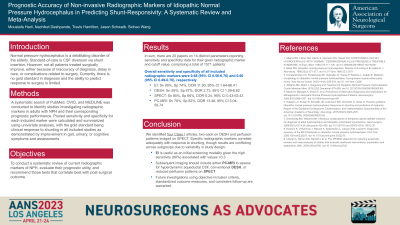Prognostic Accuracy of Radiographic Markers of Normal Pressure Hydrocephalus in Predicting Shunt-Responsiveness: A Systematic Review and Meta-Analysis
Prognostic Accuracy of Radiographic Markers of Normal Pressure Hydrocephalus in Predicting Shunt-responsiveness: A Systematic Review and Meta-analysis
Friday, April 21, 2023

- MH
Moustafa Hadi (he/him/his)
MS3
MSU CHM | Henry Ford Hospital
Dearborn, Michigan, United States
ePoster Presenter(s)
Introduction: Normal pressure hydrocephalus (NPH) is a syndrome of the elderly first described by Hakim & Adams in 1965, with clinical presentation involving a classic triad of ataxia, urinary incontinence, and dementia. Standard of treatment is CSF diversion, typically via ventriculoperitoneal shunting. Historically, determination of appropriate surgical candidates has been difficult for clinicians considering the existence of clinically similar comorbidities and complications of shunt insertion, giving rise to multiple indices used in assessing preoperative disease severity and postoperative improvement. The objective of this paper is to conduct a systematic review and meta-analysis of radiographic markers of NPH and assess their corresponding prognostic utility in identifying shunt-responsive patients prior to surgery.
Methods: A systematic search of PubMed, OVID, and MEDLINE was conducted. Pooled sensitivity/specificity for each included marker and cut-off value was calculated and summarized using univariate analyses. Random-effect model was used to account for heterogeneity between studies in the meta-analysis, and quality of evidence was summarized according to the American Academy of Neurology Clinical Practice Guideline criteria for rating prognostic accuracy studies. Gold standard was clinical response to shunting.
Results: In sum, there are 35 papers on 10 different markers. Only 19 studies reported sensitivity and specificity values for their given radiographic marker and cutoff value, comprising a total of 1975 patients. Overall sensitivity and specificity of all included radiographic markers were 0.63 (95% CI 0.48-0.76) and 0.59 (95% CI 0.43-0.73) respectively, with SPECT and PCMRI demonstrating highest prognostic value with sensitivity of 0.85 (95% CI 0.21-0.99) and 0.80 (95% CI 0.44-0.97) respectively, though only one low-powered study investigated PCMRI.
Conclusion : We identified five Class I articles. Specific radiographic markers correlate adequately with response to shunting, though results are conflicting across subgroups. SPECT is useful as an initial screening modality, with conventional DESH used as subsequent imaging. Future high-powered investigations are warranted for PCMRI.
Methods: A systematic search of PubMed, OVID, and MEDLINE was conducted. Pooled sensitivity/specificity for each included marker and cut-off value was calculated and summarized using univariate analyses. Random-effect model was used to account for heterogeneity between studies in the meta-analysis, and quality of evidence was summarized according to the American Academy of Neurology Clinical Practice Guideline criteria for rating prognostic accuracy studies. Gold standard was clinical response to shunting.
Results: In sum, there are 35 papers on 10 different markers. Only 19 studies reported sensitivity and specificity values for their given radiographic marker and cutoff value, comprising a total of 1975 patients. Overall sensitivity and specificity of all included radiographic markers were 0.63 (95% CI 0.48-0.76) and 0.59 (95% CI 0.43-0.73) respectively, with SPECT and PCMRI demonstrating highest prognostic value with sensitivity of 0.85 (95% CI 0.21-0.99) and 0.80 (95% CI 0.44-0.97) respectively, though only one low-powered study investigated PCMRI.
Conclusion : We identified five Class I articles. Specific radiographic markers correlate adequately with response to shunting, though results are conflicting across subgroups. SPECT is useful as an initial screening modality, with conventional DESH used as subsequent imaging. Future high-powered investigations are warranted for PCMRI.
